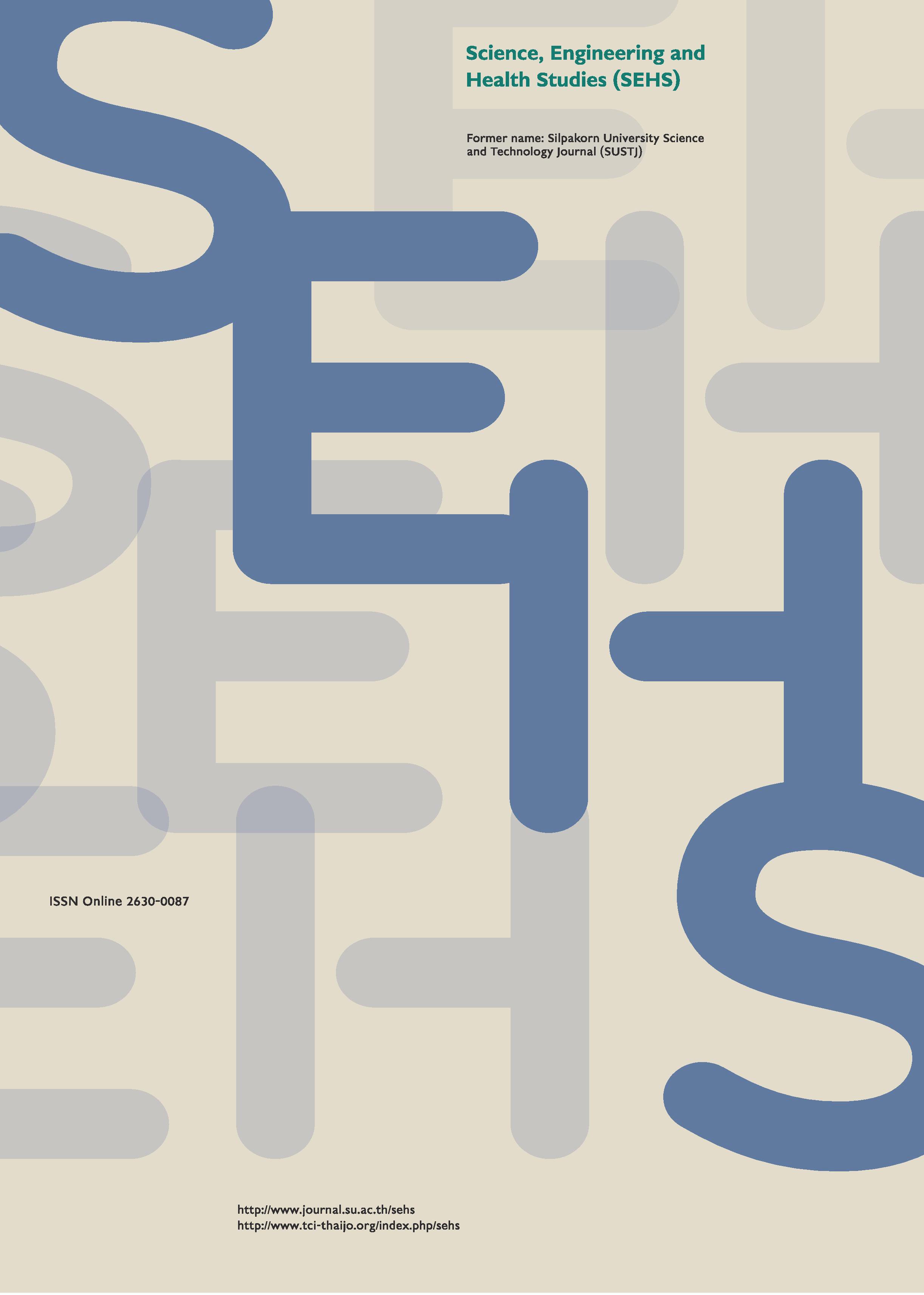Morphology and elemental components of sea turtle eggshells using scanning electron microscopy
Main Article Content
Abstract
This research analyzed the morphology and elemental components of sea turtle eggshells by using quantitative and qualitative research methods. Results showed that sea turtle eggshells were composed of three layers: outer cuticle, middle, and inner fibrous layers. The morphology of the outer cuticle layer was thick, porous, and composed of aragonite to form CaCO3. The middle layer was compact and thick, and the inner layer was compact and thin. The total layer thicknesses of the green turtle (Chelonia mydas), hawksbill sea turtle (Eretmochelys imbricate), and leatherback turtle (Dermochelys coriacea) were 251.92 ± 20.86, 236.94 ± 19.26, and 237.57 ± 18.23 mm, respectively. Elemental analysis of the eggshells of all species revealed the presence of C, O, Ca, S, F, Al, Na, Cl, Si, K, P, Mg, and I. Among the elements detected, C, O, and Ca were found at high percentages to form CaCO3, which accumulated in the outer cuticle layer. Contamination of metals and non-metals, such as Mo, Br, Cu, Pb, and Pd, was found in the three types of sea turtle eggshells. This study is fundamental in providing data to manage sea turtle conservation in the future.
Downloads
Article Details
References
Al-Bahry, S. N., Mahmoud, I. Y., Al-Amri, I. S., Ba-Omar, T. A., Melgheit, K. O., and Al-Kindi, A. Y. (2009). Ultrastructural features and elemental distribution in eggshell during pre and post hatching periods in the green turtle, Chelonia mydas at Ras Al-Hadd, Oman. Tissue and Cell, 41(3), 214-221.
Alava, J. J., Keller, J. M., Kucklick, J. R., Wyneken, J., Crowder, L., and Scott, G. I. (2006). Loggerhead sea turtle (Caretta caretta) egg yolk concentrations of persistent organic pollutants and lipid increase during the last stage of embryonic development. Science of the Total Environment, 367(1), 170-181.
Baird, T., and Solomon, S. E. (1979). Calcite and aragonite in the eggshell of Chelonia mydas L. Journal of Experimental Marine Biology and Ecology, 36(3), 295-303.
Bishop, C. A., Ng, P., Pettit, K. E., Kennedy, S. W., Stegeman, J. J., Norstrom, R. J., and Brooks, R. J. (1998). Environmental contamination and developmental abnormalities in eggs and hatchlings of the common snapping turtle (Chelydra serpentina serpentina) from the Great Lakes-St Lawrence River basin (1989-1991). Environmental Pollution, 101(1), 143-156.
Brasfield, S. M., Bradham, K., Wells, J. B., Talent, L. G., Lanno, R. P., and Janz, D. M. (2004). Development of a terrestrial vertebrate model for assessing bioavailability of cadmium in the fence lizard (Sceloporus undulates) and in ovo effects on hatchling size and thyroid function. Chemosphere, 54(11), 1643-1651.
Bustard, H. R., and Greenham, P. (1968). Physical and chemical factors affecting hatching in the green sea turtle, Chelonia mydas (L.). Ecology, 49(2), 269-276.
Carpenter, K. (1999). Making an Egg. Eggs, Nests and Baby Dinosaurs: A Look at Dinosaur Reproduction (Life of the Past). Indiana University Press, pp. 85-97.
Eckert, K. L., Bjorndal, K. A., Alberto Abreu-Grobois, F., and Donnelly, M. (1999). Research and Management Techniques for the Conservation of Sea Turtle, Pennsylvania: IUCN/SSC Marine Turtle Specialist Group Publication.
Ewert, M. A. (1985). Embryology of turtles. In Biology of the Reptilia, Vol. 14 (Gans C., Billertt F., Maderson P. F. A., eds.), pp. 75-267. New York: John Wiley & Sons Inc.
Guirlet, E., Das, K., and Girondot, M. (2008). Maternal transfer of trace elements in leatherback turtles (Dermochelys coriacea) of French Guiana. Aquatic Toxicology, 88(4), 267-276.
Kitimasak, W., Thirakhupt, K., and Moll, D. L. (2003). Eggshell structure of the Siamese narrowheaded softshell turtle Chitra chitra Nutphand, 1986 (Testudines: Trionychidae). ScienceAsia, 29, 95-98.
Lam, J. C., Tanabe, S., Chan, S. K., Lam, M. H., Martin, M., and Lam, P. K. (2006). Levels of trace elements in green turtle eggs collected from Hong Kong: evidence of risks due to selenium and nickel. Environmental Pollution, 144(3), 790-801.
Nuamsukon, S., Chuen-Im, T., Rattanayuvakorn, S., Panishkan, K., Narkkong, N., and Areekijseree, M. (2009). Thai marine turtle eggshell: Morphology, ultrastructure and composition. Journal of Microscopy Society of Thailand, 23(1), 52-56.
Osborne, L., and Thompson, M. B. (2005). Chemical composition and structure of the eggshell of three oviparous lizards. Copeia, 2005(3), 683-692.
Packard, G. C., and Packard, M. J. (1988). The Physiological Ecology of Reptilian Eggs and Embryos. In Biology of Reptilia, Vol 16 (Gans C., and Huey R. B., eds.), pp. 523-605. New York: Alan R. Liss Inc.
Romanoff, A. L. & Romanoff, A. J. (1949). The Avian Egg, New York: John Wiley & Sons Inc.
Sahoo, G., R. K. Sahoo, and Mohanty-Hejmadi, P. (1998). Calcium metabolism in olive ridley turtle eggs during embryonic development. Comparative Biochemistry and Physiology Part A, 121(1), 91-97.
Sakai, H., Ichihashi, H., Suganuma, H., and Tatsukawa, R. (1995). Heavy metal monitoring in sea turtles using eggs. Marine Pollution Bulletin, 30(5), 347-353.
Solomon, S. E., and Baird, T. (1976). Studies on the eggshell (oviducal and oviposited) of Chelonia mydas L. Journal of Experimental Marine Biology and Ecology, 22(2), 145-160.
Sikiwat, S., Areekijseree, M., Sribuddhachart, K., Kerdkriankrai, S., Namchote, S., Kittiwattanawong, K., and Thongchai, C. (2015). Comparative eggshell ultrastructure of three species of sea turtle. In Proceedings of 53rd Kasetsart University Annual Conference: Science, Genetic Engineering, Architecture and Engineering, Agro-Industry, Natural Resources and Environment, pp. 245-251. Bangkok, Thailand.
Tryfonas, A. E., Tucker, J. K., Brunkow, P. E., Johnson, K. A., Hussein, H. S., and Lin, Z. Q. (2006). Metal accumulation in eggs of the red-eared slider (Trachemys scripta elegans) in the Lower Illinois River. Chemosphere, 63(1), 39-48.
Winkler, J. D. (2006). Testing phylogenetic implications of eggshell characters in side-necked turtles (Testudines: Pleurodira). Zoology, 109(2),127-136.
Van Meter, R. J., Spotila, J. R., and Avery, H.W. (2006). Polycyclic aromatic hydrocarbons affect survival and development of common snapping turtle (Chelydra serpentina) embryos and hatchlings. Environmental Pollution, 142(3), 466-475.


